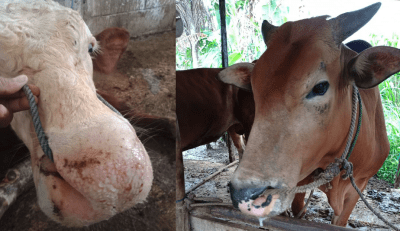It is a story no rural journalist would want to write and no one in the industry would want to read.
But the reality is that two years after lumpy skin disease and foot and mouth disease gained a foothold in nearby Indonesia, the threat of an outbreak in Australia has not gone away.
The headlines have moved on, but the potential danger has not.
An outbreak of LSD or FMD would be devastating to Australia’s livestock sector on many levels, but the most immediate impacts to be felt would be through the instant loss of market access under current trade protocols to many valuable key export markets for beef and cattle.
Such a detection would instantly alter Australia’s “free from” status, which would prevent the Australian Government from issuing export certificates, and result in an immediate suspension of trade to many markets (this differs somewhat between FMD and LSD, more details below).
Australia would then need to re-establish disease freedom and likely negotiate with individual countries to regain access, a process which would likely take months at a minimum and quite possibly years, according to World Animal Health Guidelines – with such details reliant on the nature of the outbreak as well as Australia’s ability to eradicate the disease.
This article is not intended to frighten or alarm but rather to remind that a major threat remains as is evidenced by Indonesia’s ongoing battle against FMD and LSD.
There is no automatic “we can just carry on tomorrow regardless” if an outbreak occurs here, one industry heavyweight noted to Beef Central recently.
It raises the question, what capacity does Australia have to start negotiations with key trading partners “ahead of” any future potential disease outbreak, with the hope of improving arrangements and ensuring the flow of at least some trade in the event of a worst case scenario being realised?
The old saying goes that you shouldn’t wait until the middle of a storm to fix your roof.
In that respect a key question now is this: Do these issues remain front-of-mind for Australian trade officials and industry bodies, even if they have long faded from public awareness?
According to Sam Munsie – the Australian Meat Industry Council’s general manager for trade and technical affairs – the answer is “yes”.
A concerted effort undeway behind the scenes
“The key message is that a concerted and systemic effort is underway behind the scenes to manage the risk to the best of our opportunity,” Mr Munsie told Beef Central last week.
Mr Munsie said AMIC had been working closely with Department of Agriculture, Fisheries and Forestry (DAFF) officials to prioritise discussions with trading partners with the view to managing trade risks where possible, including discussions on zoning arrangements as well as the trade in products deemed ‘safe’ under World Organization of Animal Health Guidelines.’ .
Beef Central asked Mr Munsie what potential there is to pre-emptively negotiate improved market access in the event of a future FMD or LSD outbreak.
For FMD the answer is “very limited”.
FMD is transmissible through a large range of risk products and the World Organisation for Animal Health (WOAH) necessarily places very strict standards around trading with FMD. This limits the ability to mitigate that risk ahead of any potential outbreak to only discussions on possible zoning arrangements should there be an incursion, Mr Munsie said.
The situation is slightly different for LSD however.
The World Organisation of Animal Health guidelines classify bovine skeletal muscle meat as a ‘safe commodity’ for LSD, meaning it recommends no LSD-related conditions on the trade of these products. This provides an opportunity for countries to agree to the safe trade in these products regardless of the countries’ LSD status.
This LSD risk-mitigation is where the focus has been for AMIC, Australia’s affected livestock industries and DAFF, with great progress by government in confirming these arrangements proactively with key trading partners, Mr Munsie said.
Given the uncertainties around securing advance assurances, focusing resources on not getting either disease remains a key message.
FMD stats leads to winding back of some biosecurity measures for inbound travellers
On that front, some alarm bells have rung in the industry after the Federal Government last week released official statistics showing the incidence of foot-and-mouth disease (FMD) in Indonesia has stabilised and as a result some biosecurity measures such as sanitation foot mats in Australian airports will no longer be used for flights arriving from Indonesia.
Unofficially, feedback from people with close knowledge of the situation on the ground in Indonesia have shared with Beef Central that they believe efforts to curb the spread of the disease have not been as successful as reported and official statistics reporting FMD numbers in Indonesia do not paint an accurate picture, fearing serious risks remain.
Lumpy skin disease is of particular concern because it is spread by biting insects which can be carried vast distances on wind. It has taken just 10 years for LSD to spread from Africa to Europe and through Asia to Indonesia on Australia’s northern doorstep.
In August last year a Department of Agriculture report suggested the risk of LSD making the last leg from Indonesia to Australia was “lower than previously thought”, but others within industry say they fear an LSD outbreak in Australia at some point is “inevitable”.



HAVE YOUR SAY